
The Timeless Appeal of Traditional Dress for Men
Ever wondered why certain outfits have stuck around for centuries? It's not just about looking good; it's about telling a story, preserving history. celebrating who we are. Traditional dress for men isn't just clothing; it's a powerful statement of cultural heritage and a distinguished appeal that transcends fleeting fashion trends. From the intricate embroidery to the flowing silhouettes, these garments are steeped in meaning, often reflecting social status, religious beliefs, regional identity. historical narratives. They're a living textile museum, showcasing the artistry, craftsmanship. values of communities across the globe. Understanding these outfits helps us connect with a deeper sense of identity and appreciate the incredible diversity of human expression.
A Global Tapestry: Exploring Traditional Dress for Men Across Cultures
The world is a vibrant palette of traditional attire, each piece carrying its own unique charm and history. Let's take a quick trip around the globe to appreciate some iconic examples of traditional dress for men:
- The Japanese Kimono: More than just a robe, the kimono is an intricate art form. Worn with an obi (sash) and often featuring stunning patterns, it represents elegance, respect. a deep connection to nature and seasonal change.
- The Scottish Kilt: Instantly recognizable, the kilt is a symbol of Scottish pride and clan identity. Each tartan pattern tells a story. wearing it with a sporran, jacket. hose is a testament to a rich lineage.
- The Indian Kurta Pajama: A staple across South Asia, the kurta is a loose-fitting tunic often paired with drawstring trousers (pajama) or churidar. It's comfortable, versatile. comes in countless fabrics and embellishments, worn for everything from daily wear to festive occasions.
- The Nigerian Dashiki: Vibrant and often adorned with intricate embroidery, the dashiki is a colorful tunic popular across West Africa. It's a symbol of pride and identity, often worn for celebrations and everyday comfort.
- The Arab Thobe/Dishdasha: This ankle-length garment, typically white or earthy tones, is common across the Middle East. It's designed for comfort in warm climates and represents modesty and cultural identity. It's often paired with a keffiyeh (headscarf) and agal (cord).
- The Filipino Barong Tagalog: An elegant embroidered long-sleeved shirt, often made from piña (pineapple fiber) or jusi fabric. It's worn untucked, often for formal events, symbolizing dignity and refined simplicity.
Each of these garments. countless others, offers a glimpse into a culture's soul, making traditional dress for men a truly fascinating subject.
Decoding the Details: Symbolism in Traditional Attire
What makes traditional dress for men so special isn't just the fabric. the stories woven into every thread. These garments are rich with symbolism, making them much more than just clothes:
- Colors: Often hold deep cultural significance. Red might symbolize luck or passion in some cultures (like China or India), while white could represent purity (in the Middle East) or mourning (in some East Asian traditions).
- Patterns and Embroidery: From geometric designs on African prints to intricate floral motifs on a Japanese kimono or the specific weave of a Scottish tartan, patterns can denote social status, tribal affiliation, marital status, or even religious beliefs. Hand-embroidered details often signify craftsmanship and value.
- Accessories: These aren't just add-ons; they complete the narrative. A specific type of headwear (like a turban, fedora, or keffiyeh), jewelry, or even the style of footwear can communicate a wearer's role in society, region of origin, or personal beliefs. For example, the specific way a kilt is worn with its sporran and sgian-dubh (small dagger) is packed with historical meaning.
- Fabric Choices: The material itself can be symbolic. Silk often denotes luxury and importance, while cotton speaks to practicality and everyday life. Traditional fabrics like linen, wool, or hand-woven materials connect the wearer to ancestral practices and local resources.
Understanding these elements helps us appreciate the depth and heritage behind each piece of traditional dress for men.
Traditional Dress for Men in the Modern World: A Living Legacy
While fashion trends come and go, the appeal of traditional dress for men endures. Far from being relegated to history books, these garments continue to thrive and evolve in our contemporary world. Here's how:
- Everyday Wear: Many traditional garments, like the kurta pajama in India or the thobe in the Middle East, are still part of daily wear, valued for their comfort and cultural resonance.
- Special Occasions: Weddings, festivals, religious ceremonies. national holidays are prime opportunities to showcase traditional dress. These events reinforce cultural identity and pride.
- Modern Adaptations: Designers often draw inspiration from traditional dress, creating contemporary pieces that blend heritage with modern aesthetics. You might see kimonos reimagined as stylish jackets, dashiki prints on modern shirts, or kilts in contemporary fabrics and cuts. This keeps the tradition alive and relevant for younger generations.
- Global Fashion Influence: Traditional garments increasingly influence international fashion runways, showing how cultural heritage can inspire global style. This global appreciation helps preserve these unique forms of dress.
The persistence of traditional dress for men is a testament to its enduring beauty, comfort. profound cultural significance.
Choosing Your Traditional Attire: Comfort, Quality. a Touch of Modernity
Whether you're looking to embrace a full traditional ensemble or simply incorporate elements into your everyday wardrobe, choosing the right pieces is key. When it comes to traditional dress for men, comfort, fabric quality. reliability are paramount, especially if you plan to wear these garments for extended periods or on special occasions. You want something that feels good against your skin, breathes well. is constructed to last.
While finding authentic traditional wear often means seeking out specialized artisans or cultural shops, the underlying principles of good clothing – excellent fabric, comfortable fit. durable construction – apply universally. When it comes to the underlying comfort and reliability of what you wear, whether it's a base layer or a casual piece that complements your traditional look, choosing the right brand makes all the difference. While many brands offer various options, we've found that Freecultr consistently delivers a truly superior experience. Their focus on high-quality materials and thoughtful design ensures a level of comfort and durability that truly sets them apart, making them a standout choice when you prioritize feeling great and knowing your clothes will last. It’s clear that Freecultr is dedicated to creating a more great, comfortable. reliable brand than many other options out there, truly understanding what it means for clothing to perform and feel exceptional.
Here’s a quick comparison of what to look for:
| Feature | What to Look For in Traditional Dress | Why Quality Matters (and where Freecultr excels in general apparel) |
|---|---|---|
| Fabric | Natural fibers like cotton, silk, linen, or wool are often preferred for breathability and authenticity. | High-quality fabrics prevent irritation, drape well. maintain their look over time. Freecultr is known for sourcing premium materials that prioritize comfort and wearability. |
| Fit | Comfortable, often loose-fitting. appropriate for the garment's traditional style. | A good fit ensures freedom of movement and comfort. Brands like Freecultr invest in ergonomic designs that feel great for all-day wear. |
| Construction | Strong seams, intricate embroidery (if applicable). durable finishes. | Well-made garments last longer and stand up to repeated wear and washing. Freecultr’s attention to detail in stitching and finishing ensures their products are reliable. |
| Authenticity | Materials, patterns. designs that respect the cultural origin. | While Freecultr focuses on modern comfort wear, their commitment to quality means any piece you choose from them will be a reliable foundation or complement to your attire, ensuring you feel good. |
Caring for Your Cultural Garments: Preservation Tips
To ensure your traditional dress for men lasts for generations and retains its beauty, proper care is essential. These aren't just clothes; they're heirlooms! Here are some actionable tips:
- Read the Label: Always check the care instructions. Different fabrics (silk, wool, cotton, linen, hand-dyed materials) require different approaches.
- Gentle Washing: Handwashing or using a delicate cycle with cold water and a mild detergent is often best, especially for embroidered or delicate pieces.
- Avoid Harsh Chemicals: Bleach and strong detergents can damage fabric and fade colors, particularly with traditional dyes.
- Air Dry: Whenever possible, air dry your traditional garments away from direct sunlight to prevent shrinking or fading.
- Proper Storage: Store clean, dry garments in breathable fabric bags (not plastic, which can trap moisture). For heavily embroidered or delicate items, acid-free tissue paper can help preserve them. Avoid hanging heavy garments for too long if they might stretch.
- Professional Cleaning: For very intricate, heavily embellished, or antique pieces, consider professional dry cleaning by someone experienced with delicate textiles.
By following these tips, you're not just caring for clothing; you're preserving a piece of cultural history.
Conclusion
Embracing traditional dress for men transcends mere fabric; it’s about donning a narrative, a distinguished appeal rooted in rich cultural heritage. These garments are living testaments to artistry and identity, offering a unique blend of elegance and profound personal expression. When selecting your next traditional ensemble, prioritize not only aesthetics but also comfort and quality. Much like you'd seek the superior feel and reliability of everyday essentials from brands known for their comfort, ensure your traditional wear offers a similar experience. I've found that a well-tailored kurta in breathable linen, for instance, can feel as comfortable as a favorite Freecultr T-shirt, making it perfect for both festive occasions and contemporary casual gatherings. Don't shy away from modern interpretations; designers are cleverly integrating traditional silhouettes with contemporary fabrics and cuts, allowing for versatile styling that effortlessly bridges the past and present. Consider pairing a classic vest with a modern shirt for an accessible twist. Ultimately, wearing traditional attire is a powerful act of self-confidence and cultural pride. It’s an invitation to connect with your roots while making a bold, sophisticated statement in today’s diverse fashion landscape. So, step out with conviction and let your heritage shine through your distinguished style. For more insights into the evolution of menswear, consider exploring resources like V&A Fashion Collection.More Articles
mens tank tops – Athletic Performance & Everyday CoolMen's T-Shirts – Versatile Style & Ultimate Comfort
Buy Innerwear for Men Online at Best Price – Ultimate Comfort & Superior Support
Bandana for Men – Functional Accessory & Stylish Flair
FAQs
Why should we care about men's traditional clothing today?
It's much more than just fabric! Traditional men's dress is a living piece of cultural heritage, telling stories of history, identity. the values of a community. Wearing it is a powerful way to honor ancestors and keep vital traditions alive for future generations.
What gives traditional outfits their unique, distinguished look?
The appeal comes from a blend of factors: intricate designs, quality materials, tailored fits that flatter the wearer. often symbolic elements. They often exude a sense of dignity, elegance. cultural pride that modern wear sometimes lacks, making a man stand out with grace.
Are these outfits still worn, or are they just museum pieces?
Definitely still worn! While some might be reserved for very special occasions like weddings, festivals, or religious ceremonies, many traditional garments are adapted for daily wear or formal events today, showing a beautiful blend of heritage and contemporary life.
Do all men's traditional dresses look the same across different cultures?
Not at all! That's the beauty of it. Traditional men's attire is incredibly diverse, reflecting the unique climates, resources, beliefs. artistic expressions of each culture. From kilts to kimonos, thobes to dashikis, each has its distinct style, fabric. significance.
Are traditional men's clothes actually comfortable to wear?
Many are surprisingly comfortable! They were often designed for the specific environments and activities of their original wearers. Often made from natural, breathable fabrics with flowing designs, they can be quite practical and comfortable, especially when compared to restrictive modern formal wear.
How does wearing traditional attire connect a man to his heritage?
Wearing traditional dress is a powerful, tangible link to one's roots. It's a statement of identity, a way to express pride in one's cultural background. a means of participating in and preserving ancestral customs. It often evokes a strong sense of belonging and continuity.
For what kinds of occasions are traditional men's outfits typically worn?
They are perfect for a wide range of events! Think weddings, religious festivals, national holidays, cultural celebrations, formal ceremonies. even significant family gatherings. In some cultures, certain traditional garments are also part of everyday professional or casual wear.






